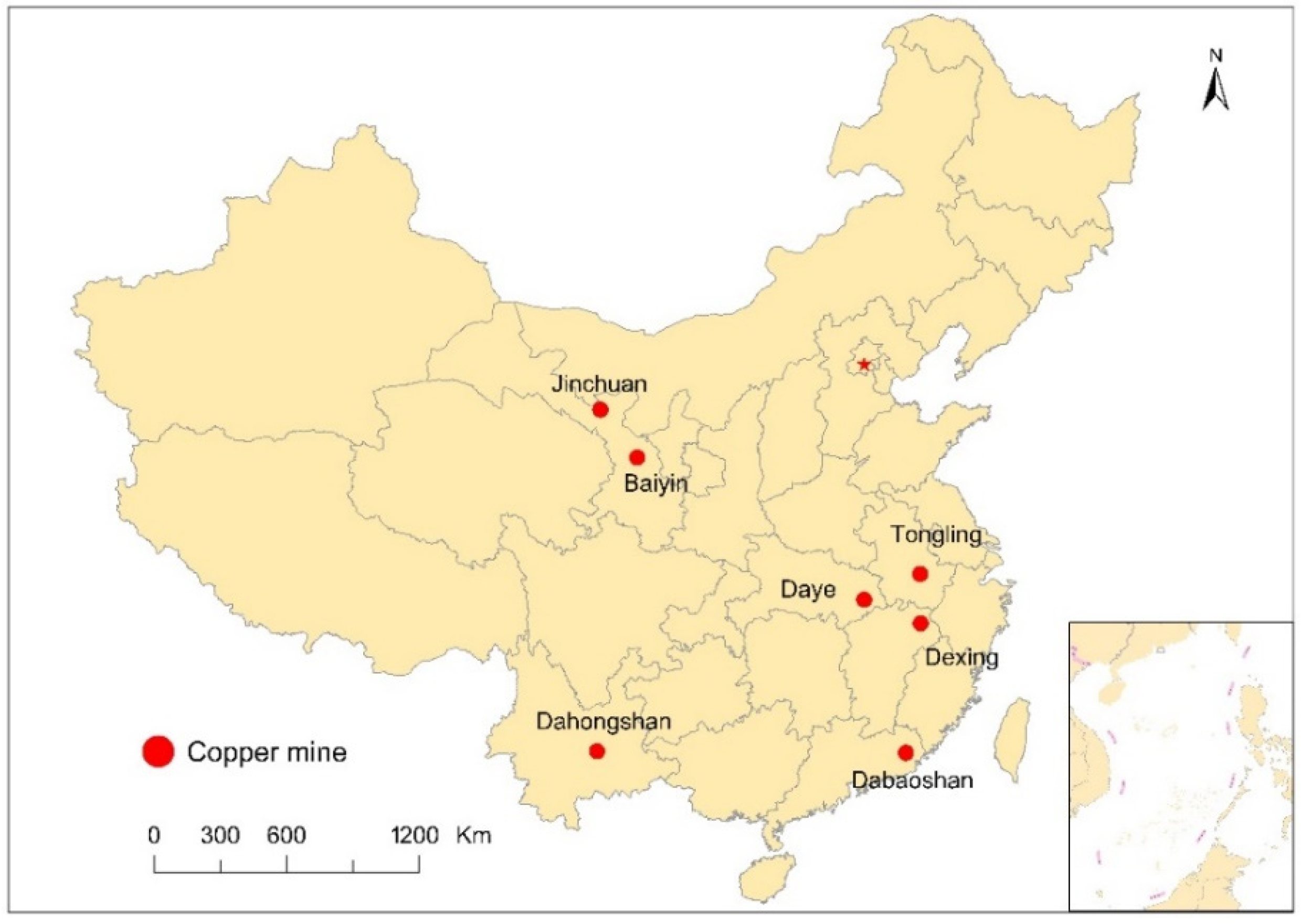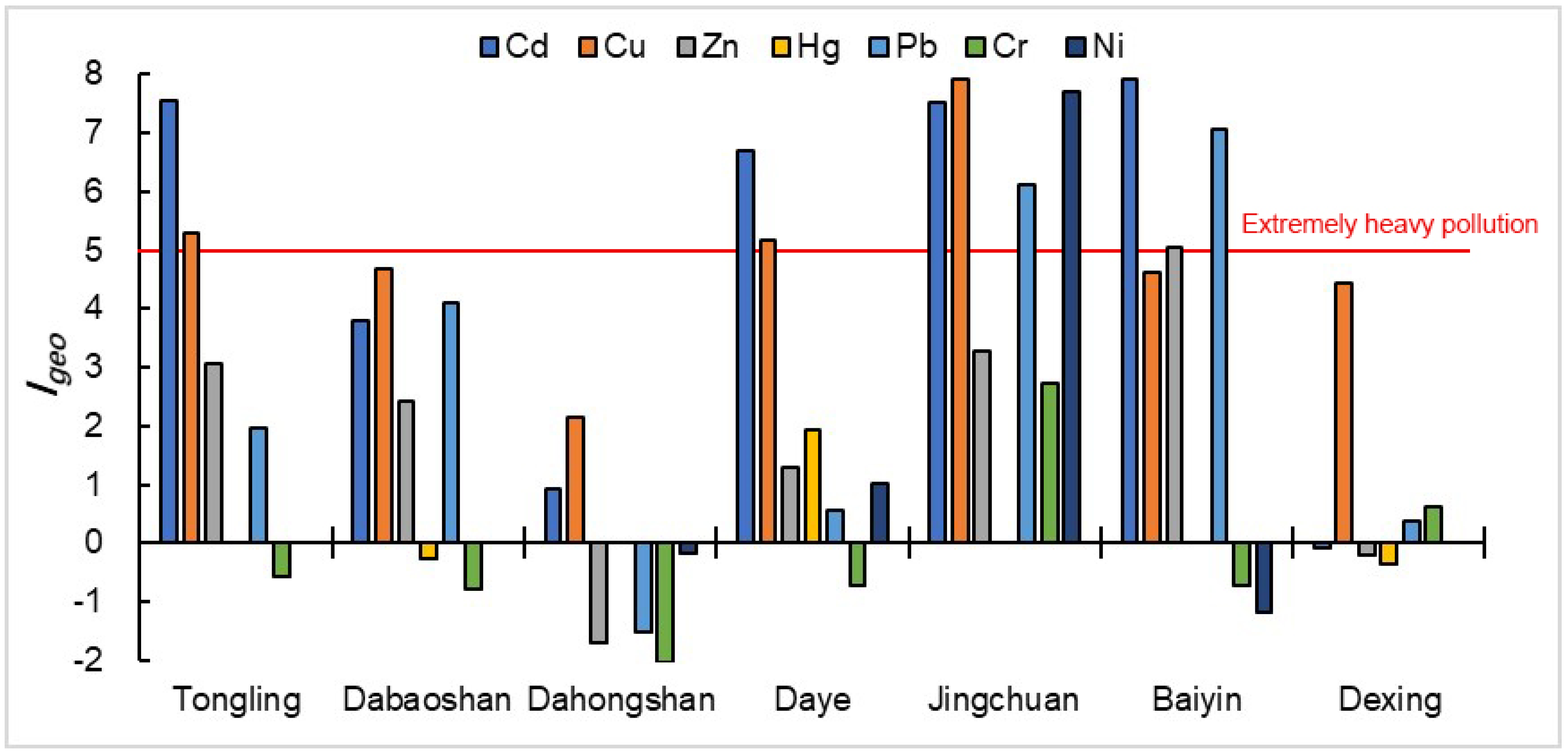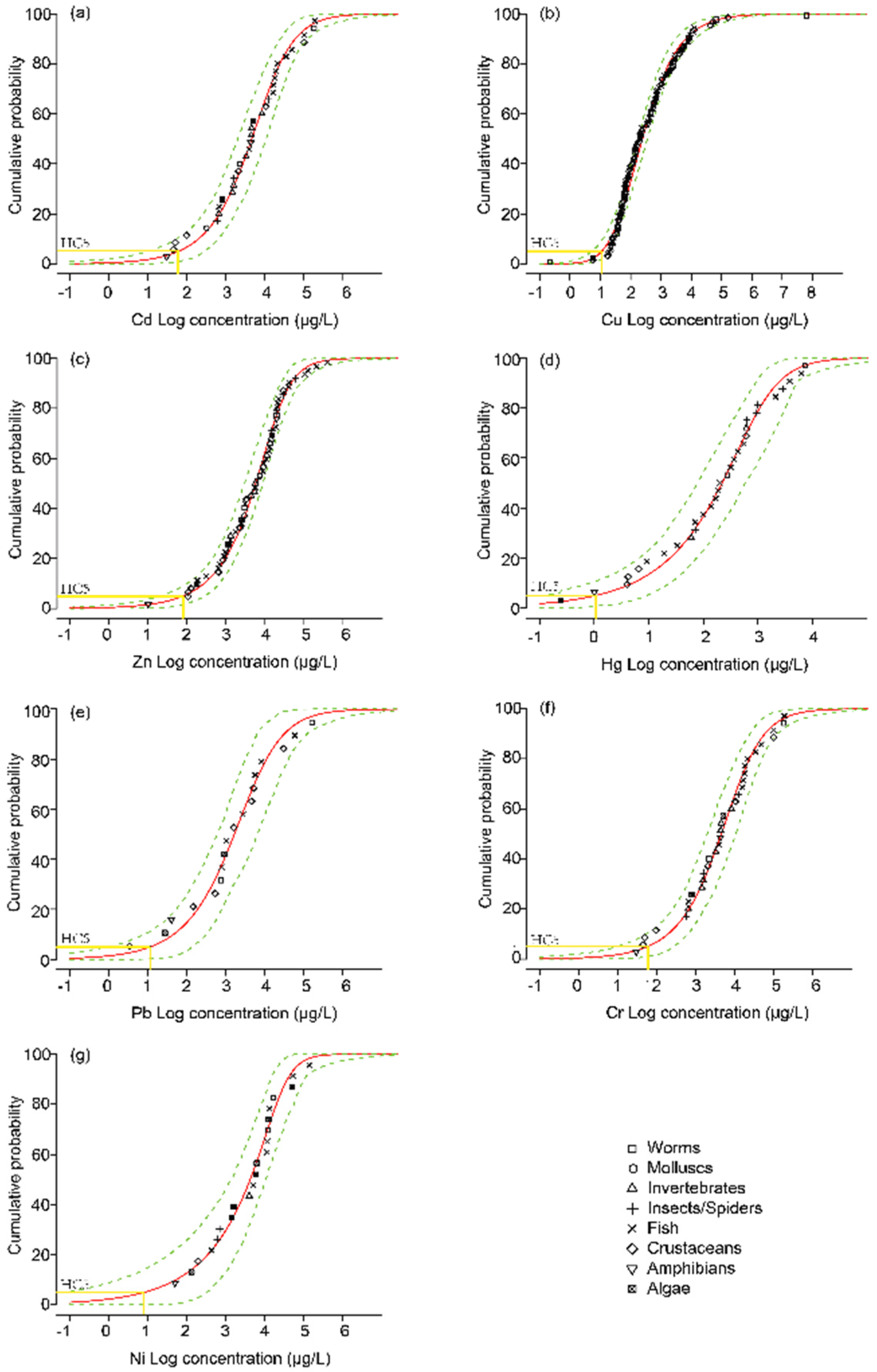Ecological Risk Assessment of Heavy Metals in Water Bodies around Typical Copper Mines in China
Abstract
1. Introduction
2. Materials and Methods
2.1. Data Source and Processing
2.2. Potential Ecological Risk Index
2.3. Geoaccumulation Index
2.4. Nemerow Index
2.5. Species Sensitivity Distribution
3. Results
3.1. Heavy Metals in River Water
3.2. Heavy Metal in Sediment
3.3. Sediment Ecological Risk Analysis
3.4. Species Sensitivity Analysis Based Ecological Risk Assessment
3.5. Limitations
4. Conclusions
Author Contributions
Funding
Acknowledgments
Conflicts of Interest
References
- Wu, J.; Li, J.; Teng, Y.; Chen, H.; Wang, Y. A partition computing-based positive matrix factorization (PC-PMF) approach for the source apportionment of agricultural soil heavy metal contents and associated health risks. J. Hazard. Mater. 2020, 388, 121766. [Google Scholar] [CrossRef] [PubMed]
- Lopezarce, P.; Garrido, F.; Garciaguinea, J.; Voegelin, A.; Gottlicher, J.; Nieto, J.M. Historical roasting of thallium- and arsenic-bearing pyrite: Current Tl pollution in the Riotinto mine area. Sci. Total Environ. 2019, 648, 1263–1274. [Google Scholar] [CrossRef] [PubMed]
- Wu, J.; Teng, Y.; Lu, S.; Wang, Y.; Jiao, D. Evaluation of Soil Contamination Indices in a Mining Area of Jiangxi, China. PLoS ONE 2014, 9, e112917. [Google Scholar] [CrossRef] [PubMed]
- Zhou, Q.; Yang, N.; Li, Y.; Ren, B.; Ding, X.; Bian, H.; Yao, X. Total concentrations and sources of heavy metal pollution in global river and lake water bodies from 1972 to 2017. Glob. Ecol. Conserv. 2020, 22, e00925. [Google Scholar] [CrossRef]
- Aslam, S.; Chan, M.W.; Siddiqui, G.; Boczkaj, G.; Kazmi, S.J.; Kazmi, M.R. A comprehensive assessment of environmental pollution by means of heavy metal analysis for oysters’ reefs at Hab River Delta, Balochistan, Pakistan. Mar. Pollut. Bull. 2020, 153, 110970. [Google Scholar] [CrossRef] [PubMed]
- Nguyen, B.T.; Do, D.D.; Nguyen, T.X.; Nguyen, V.N.; Nguyen, D.T.; Nguyen, M.H.; Bach, Q. Seasonal, spatial variation, and pollution sources of heavy metals in the sediment of the Saigon River, Vietnam. Environ. Pollut. 2019, 256, 113412. [Google Scholar] [CrossRef]
- Lu, H.; Yu, S. Spatio-temporal variational characteristics analysis of heavy metals pollution in water of the typical northern rivers, China. J. Hydrol. 2018, 559, 787–793. [Google Scholar] [CrossRef]
- Gozzard, E.; Mayes, W.M.; Potter, H.A.B.; Jarvis, A.P. Seasonal and spatial variation of diffuse (non-point) source zinc pollution in a historically metal mined river catchment, UK. Environ. Pollut. 2011, 159, 3113–3122. [Google Scholar] [CrossRef]
- El Azhari, A.; Rhoujjati, A.; El Hachimi, M.L.; Ambrosi, J.P. Pollution and ecological risk assessment of heavy metals in the soil-plant system and the sediment-water column around a former Pb/Zn-mining area in NE Morocco. Ecotoxicol. Environ. Saf. 2017, 144, 464–474. [Google Scholar] [CrossRef] [PubMed]
- Liao, J.; Chen, J.; Ru, X.; Chen, J.; Wu, H.; Wei, C. Heavy metals in river surface sediments affected with multiple pollution sources, South China: Distribution, enrichment and source apportionment. J. Geochem. Explor. 2017, 176, 9–19. [Google Scholar] [CrossRef]
- Chen, M.; Li, F.; Tao, M.; Hu, L.; Shi, Y.; Liu, Y. Distribution and ecological risks of heavy metals in river sediments and overlying water in typical mining areas of China. Mar. Pollut. Bull. 2019, 146, 893–899. [Google Scholar] [CrossRef] [PubMed]
- Kumar, V.; Parihar, R.D.; Sharma, A.; Bakshi, P.; Sidhu, G.P.S.; Bali, A.S.; Rodrigo-Comino, J. Global evaluation of heavy metal content in surface water bodies: A meta-analysis using heavy metal pollution indices and multivariate statistical analyses. Chemosphere 2019, 236, 124364. [Google Scholar] [CrossRef] [PubMed]
- Luo, C.; Routh, J.; Dario, M.; Sarkar, S.; Wei, L.; Luo, D.; Liu, Y. Distribution and mobilization of heavy metals at an acid mine drainage affected region in South China, a post-remediation study. Sci. Total Environ. 2020, 724, 138122. [Google Scholar] [CrossRef] [PubMed]
- Li, J.; Fan, J.; Jiang, J. Human health risk assessment of soil in an abandoned arsenic plant site: Implications for contaminated site remediation. Environ. Earth Sci. 2019, 78, 673–675. [Google Scholar] [CrossRef]
- Li, J.; Song, L.; Chen, H.; Wu, J.; Teng, G. Source apportionment of potential ecological risk posed by trace metals in the sediment of the Le’an River, China. J. Soils Sediments 2020, 20, 2460–2470. [Google Scholar] [CrossRef]
- Gao, Z. Evaluation of heavy metal pollution and its ecological risk in one river reach of a gold mine in Inner Mongolia, Northern China. Int. Biodeterior. Biodegrad. 2018, 128, 94–99. [Google Scholar] [CrossRef]
- Liao, J.; Ru, X.; Xie, B.; Zhang, W.; Wu, H.; Wu, C.; Wei, C. Multi-phase distribution and comprehensive ecological risk assessment of heavy metal pollutants in a river affected by acid mine drainage. Ecotoxicol. Environ. Saf. 2017, 141, 75–84. [Google Scholar] [CrossRef]
- Liu, K.; Li, C.; Tang, S.; Shang, G.; Yu, F.; Li, Y. Heavy metal concentration, potential ecological risk assessment and enzyme activity in soils affected by a lead-zinc tailing spill in Guangxi, China. Chemosphere 2020, 251, 126415. [Google Scholar] [CrossRef]
- Wang, K.; Lin, Z.; Zhang, R. Impact of phosphate mining and separation of mined materials on the hydrology and water environment of the Huangbai River basin, China. Sci. Total Environ. 2016, 543, 347–356. [Google Scholar] [CrossRef]
- Suthar, S.; Nema, A.K.; Chabukdhara, M.; Gupta, S.K. Assessment of metals in water and sediments of Hindon River, India: Impact of industrial and urban discharges. J. Hazard. Mater. 2009, 171, 1088–1095. [Google Scholar] [CrossRef]
- He, M.; Wang, Z.; Tang, H. The chemical, toxicological and ecological studies in assessing the heavy metal pollution in Le an River, China. Water Res. 1998, 32, 510–518. [Google Scholar] [CrossRef]
- Pulford, I.D.; MacKenzie, A.B.; Donatello, S.; Hastings, L. Source term characterisation using concentration trends and geochemical associations of Pb and Zn in river sediments in the vicinity of a disused mine site: Implications for contaminant metal dispersion processes. Environ. Pollut. 2009, 157, 1649–1656. [Google Scholar] [CrossRef] [PubMed]
- Li, R.; Jiang, Y.; Pan, C.; Chen, J.; Xu, J. Fraction distribution and risk assessment of heavy metals in stream sediments from a typical nonferrous metals mining city. Environ. Sci. 2013, 34, 1067–1075. [Google Scholar]
- Teng, Y.; Ni, S.; Wang, J.; Zuo, R.; Yang, J. A geochemical survey of trace elements in agricultural and non-agricultural topsoil in Dexing area, China. J. Geochem. Explor. 2010, 104, 118–127. [Google Scholar] [CrossRef]
- Chen, F. Research on Heavy Metal Elements Pollution in Xiangling River and Its Surroundings in Tongling. Master’s Thesis, Hefei University of Technology, Anhui, China, 2006. [Google Scholar]
- Zhou, J.; Dang, Z.; Cai, M. Speciation distribution and transfer of heavy metals in contaminated stream waters around Dabaoshan mine. Res. Environ. Sci. 2005, 18, 5–10. [Google Scholar]
- Yang, Z.; Hu, M.; Huang, S. Heavy metals pollution in stream sediments and potential ecological risk assessment in dabaoshan mining area. J. Guilin Univ. Technol. 2007, 27, 44648. [Google Scholar]
- Li, X. Distribution Characteristics of Heavy Metals Such as Cu in Rivers and Soils around Dahongshan Copper Mine in Yunnan. Master’s Thesis, Capital Normal University, Beijing, China, 2009. [Google Scholar]
- Zhang, X.; Hu, M. Heavy Metal Distribution of Creek Water and Its Sediments in Tieshan, Daye, Hubei Province. Geol. Sci. Technol. Inf. 2006, 25, 89–92. [Google Scholar]
- Li, X. Research on Environmental Pollution and Prevention of Large Metal Mines. Master’s Thesis, Lanzhou University, Lanzhou, China, 2007. [Google Scholar]
- Zhao, Y.; Wang, J. Geological Environment Model and Environmental Evaluation of Mineral Deposits; Geological Publishing House: Beijing, China, 2007; pp. 64–65. [Google Scholar]
- ECOTOX Knowledgebase. Available online: https://cfpub.epa.gov/ecotox (accessed on 9 October 2019).
- Duboudin, C.; Ciffroy, P.; Magaud, H. Acute-to-chronic species sensitivity distribution extrapolation. Environ. Toxicol. Chem. Int. J. 2004, 23, 1774–1785. [Google Scholar] [CrossRef]
- Feng, Y.; Bao, Q.; Yunpeng, C.; Lizi, Z.; Xiao, X. Stochastic potential ecological risk model for heavy metal contamination in sediment. Ecol. Indic. 2019, 102, 246–251. [Google Scholar] [CrossRef]
- Muller, G. Heavy-metals in sediment of the Rhine-changes since 1971. Umsch. Wiss. Tech. 1979, 79, 778–783. [Google Scholar]
- Huang, L.; Rad, S.; Xu, L.; Gui, L.; Song, X.; Li, Y.; Wu, Z.; Chen, Z. Heavy Metals Distribution, Sources, and Ecological Risk Assessment in Huixian Wetland, South China. Water 2020, 12, 431. [Google Scholar] [CrossRef]
- Mazurek, R.; Kowalska, J.; Gąsiorek, M.; Zadrozny, P.; Jozefowska, A.; Zaleski, T.; Orlowska, K. Assessment of heavy metals contamination in surface layers of Roztocze National Park forest soils (SE Poland) by indices of pollution. Chemosphere 2017, 168, 839–850. [Google Scholar] [CrossRef] [PubMed]
- Shao, Q. Estimation for hazardous concentrations based on NOEC toxicity data: An alternative approach. Environmetrics 2000, 11, 583–595. [Google Scholar] [CrossRef]
- Li, H.; Sun, Z.; Qiu, Y.; Yu, X.; Han, X.; Ma, Y. Integrating bioavailability and soil aging in the derivation of DDT criteria for agricultural soils using crop species sensitivity distributions. Ecotoxicol. Environ. Saf. 2018, 165, 527–532. [Google Scholar] [CrossRef] [PubMed]
- Van Straalen, N.M. Threshold models for species sensitivity distributions applied to aquatic risk assessment for zinc. Environ. Toxicol. Pharmacol. 2002, 11, 167–172. [Google Scholar] [CrossRef]
- Zhao, J.; Chen, B. Species sensitivity distribution for chlorpyrifos to aquatic organisms: Model choice and sample size. Ecotoxicol. Environ. Saf. 2016, 125, 161–169. [Google Scholar] [CrossRef]
- He, J.; He, H.; Yan, Z.; Gao, F.; Zheng, X.; Fan, J.; Wang, Y. Comparative analysis of freshwater species sensitivity distributions and ecotoxicity for priority pesticides: Implications for water quality criteria. Ecotoxicol. Environ. Saf. 2019, 176, 119–124. [Google Scholar] [CrossRef]
- Wang, Y.; Dong, R.; Zhou, Y.; Luo, X. Characteristics of groundwater discharge to river and related heavy metal transportation in a mountain mining area of Dabaoshan, Southern China. Sci. Total Environ. 2019, 679, 346–358. [Google Scholar] [CrossRef]
- Guo, Y.; Huang, P.; Zhang, W.G.; Yuan, X.; Fan, F.; Wang, H.; Wang, Z.H. Leaching of heavy metals from Dexing copper mine tailings pond. Trans. Nonferr. Met. Soc. China 2013, 23, 3068–3075. [Google Scholar] [CrossRef]
- WHO. Guidelines for Drinking-Water Quality; WHO: Geneva, Switzerland, 2011; pp. 327–328. [Google Scholar]
- Xu, Y.; Wu, Y.; Han, J.; Li, P. The current status of heavy metal in lake sediments from China: Pollution and ecological risk assessment. Ecol. Evolut. 2017, 7, 5454–5466. [Google Scholar] [CrossRef]
- Woitke, P.; Wellmitz, J.; Helm, D.; Kube, P.; Lepom, P.; Litheraty, P. Analysis and assessment of heavy metal pollution in suspended solids and sediments of the river Danube. Chemosphere 2003, 51, 633–642. [Google Scholar] [CrossRef]
- Yan, B.; Xu, D.; Chen, T.; Yan, Z.; Li, L.; Wang, M.H. Leachability characteristic of heavy metals and associated health risk study in typical copper mining-impacted sediments. Chemosphere 2020, 239, 124748. [Google Scholar] [CrossRef] [PubMed]
- Gyamfi, E.; Appiah-Adjei, E.K.; Adjei, K.A. Potential heavy metal pollution of soil and water resources from artisanal mining in Kokoteasua, Ghana. Groundw. Sustain. Dev. 2019, 8, 450–456. [Google Scholar] [CrossRef]
- Wang, Z.; Hong, C.; Xing, Y.; Wang, K.; Li, Y.; Feng, L.; Ma, S. Spatial distribution and sources of heavy metals in natural pasture soil around copper-molybdenum mine in Northeast China. Ecotoxicol. Environ. Saf. 2018, 154, 329–336. [Google Scholar] [CrossRef] [PubMed]




| Copper Mine | Sediment | Water | ||
|---|---|---|---|---|
| Heavy Metal | Analysis Methods | Heavy Metal | Analysis Methods | |
| Tongling [25] | Cu, Zn, Pb, Cr | XRF | Cd, Cu, Zn, Cr | AFS |
| Cd | AAS | Hg | XRF | |
| Dabaoshan [26,27] | Cd, Cr | ICP-MS | Cd, Cu, Zn, Pb | ICP-OES |
| Hg, Pb | AFS | |||
| Zn, Cu | ICP-OES | |||
| Dahongshan [28] | Cu, Cr, Cd, Pb, Zn, Ni | ICP-MS | Cu, Cr, Cd, Pb, Zn, Ni | ICP-MS |
| Daye [29] | Cd, Cr, Ni | ICP-MS | Cd, Cr, Ni | ICP-MS |
| Cu, Zn, | ICP-OES | Cu, Zn, | ICP-OES | |
| Hg, Pb | AFS | Hg, Pb | AFS | |
| Jinchuan [30] | Cu, Zn, Pb, Cr, Cd, Ni | ICP-AES | Cu, Zn, Pb, Cr, Cd, Ni | ICP-AES |
| Baiyin [30] | Cu, Zn, Pb, Cr, Cd, Ni | ICP-AES | Cu, Zn, Pb, Cr, Cd, Ni | ICP-AES |
| Dexing [31] | Cu, Zn, Cr | ICP-AES | Cu, Zn, Cr | ICP-AES |
| Cd, Hg | AAS | Cd, Hg | AAS | |
| Region | Cd | Cu | Zn | Hg | Pb | Cr | Ni |
|---|---|---|---|---|---|---|---|
| Tongling [25] | 0.0001–0.083 | 0.001–0.374 | 0.001–0.72 | 0.000011–0.000058 | - | 0.002–0.012 | - |
| (0.014) | (0.083) | (0.129) | (0.000043) | - | (0.0058) | - | |
| Dabaoshan [26] | 0.002–0.1 | 0.008–13.82 | 0.021–50.83 | - | 0.001–2.91 | - | - |
| (0.031) | (3.92) | (14.35) | - | (8.08) | - | - | |
| Dahongshan [28] | 0.004–0.03 | 0.39–12.7 | 33.9–57 | - | 0.3–0.56 | 9.37–14.9 | 2.23–3.51 |
| (0.016) | (9.14) | (42.86) | - | (0.4) | (11.78) | (2.96) | |
| Daye [29] | 0.00001–0.125 | 0.00096–0.019 | 0.014–0.32 | 0.0002–0.0003 | 0.00003–0.00032 | 0.00002–0.016 | 0.0011–0.048 |
| (0.024) | (0.0087) | (0.073) | (0.00023) | (0.00011) | (0.0028) | (0.02) | |
| Jingchuan [30] | 0.001–0.005 | 0.018–22.41 | 0.007–0.14 | - | 0.01–0.14 | 0.003–0.983 | 0.057–6.85 |
| (0.001) | (3.086) | (0.0059) | - | (0.054) | (0.167) | (1.427) | |
| Baiyin [30] | 0.83–1.82 | 3.581–40.32 | 1.69–7.69 | - | 0.048–2.551 | - | - |
| (1.18) | (13.82) | (3.71) | - | (1.36) | - | - | |
| Dexing [31] | 0.00004–0.054 | 0.00003–135.99 | 0.00003–11.18 | 0.000009–0.00008 | 0.00011–0.25 | 0.0047–0.64 | - |
| (0.0082) | (23.53) | (2.04) | (0.000047) | (0.024) | (0.14) | - | |
| WHO [45] | 0.003 | 2 | 0.05 | 0.001 | 0.01 | 0.05 | 0.02 |
| Region | Cd | Cu | Zn | Hg | Pb | Cr | Ni |
|---|---|---|---|---|---|---|---|
| Tongling [25] | 1.18–79.55 | 374–2181.8 | 198–2162.5 | - | 53.9–410 | 30.6–132.7 | - |
| (19.67) | (1167.13) | (844.89) | - | (137.81) | (54.23) | - | |
| Dabaoshan [27] | 0.07–6.2 | 24–3180 | 3.4–2780 | 0.04–0.09 | 24.9–6400 | 7.8–154 | - |
| (1.45) | (766.22) | (545.36) | (0.05) | (606.65) | (47.03) | - | |
| Dahongshan [28] | 0.12–0.32 | 37.86–222.68 | 21.68–47.91 | - | 5.76–17.56 | 15.26–22.68 | 23.2–47.57 |
| (0.20) | (132.19) | (31.27) | - | (12.30) | (19.61) | (33.23) | |
| Daye [29] | 0.22–41.4 | 19–1410 | 199–318 | 0.12–0.33 | 19-156 | 22.1–130 | 29.4–99.2 |
| (10.78) | (1074.83) | (246.50) | (0.23) | (52.33) | (49.37) | (75.90) | |
| Jingchuan [30] | 12.42–27.37 | 5317.34–8377 | 774.3–1264.83 | - | 752–5507.18 | 408.8–648.48 | 5068–13112. |
| (19.21) | (7265.37) | (977.27) | - | (2475.33) | (539.32) | (7781.03) | |
| Baiyin [30] | 1.17–70.64 | 79.78–1519.5 | 117.32–10725 | - | 143.93–9999 | 34.63–61.63 | 9.79–23.91 |
| (25.31) | (742.24) | (3363.43) | - | (4722.14) | (49.4) | (16.52) | |
| Dexing [31] | 0.051–0.18 | 126–2978 | 20.6–145 | 0.015–0.12 | 27.4–76.1 | 75.7–233 | |
| (0.1) | (645.63) | (88.2) | (0.047) | (46.19) | (125.14) |
| Region | Cd | Cu | Zn | Hg | Pb | Cr | Ni | RI |
|---|---|---|---|---|---|---|---|---|
| Tongling | 8430 | 291.78 | 12.48 | 29.19 | 2 | 8765.47 | ||
| Dabaoshan | 621.43 | 191.56 | 8.05 | 37.5 | 128.53 | 1.75 | 988.81 | |
| Dahongshan | 85.71 | 33.05 | 0.46 | 2.61 | 0.73 | 6.67 | 129.23 | |
| Daye | 4620 | 268.71 | 3.64 | 172.5 | 11.09 | 1.84 | 15.24 | 5093 |
| Jingchuan | 8232.85 | 1816.34 | 14.43 | 524.43 | 20.01 | 1562.46 | 2170.54 | |
| Baiyin | 10,847.14 | 185.56 | 49.68 | 1000.45 | 1.83 | 3.32 | 12,087.99 | |
| Dexing | 42.86 | 161.41 | 1.30 | 35.25 | 9.79 | 4.64 | 255.25 |
| Region | Cd | Cu | Zn | Hg | Pb | Cr | Ni | MSPAF |
|---|---|---|---|---|---|---|---|---|
| Tongling | 5 | 30 | 7 | 1 | 0.39 | |||
| Dabaoshan | 8 | 87 | 71 | 76 | 0.99 | |||
| Dahongshan | 6 | 91.7 | 89 | 29 | 27 | 44 | 0.99 | |
| Daye | 7 | 4 | 5 | 3 | 0 | 1 | 7 | 0.24 |
| Jingchuan | 1 | 85 | 4 | 11 | 9 | 34 | 0.92 | |
| Baiyin | 49 | 93.5 | 41 | 47 | 0.99 | |||
| Dexing | 4 | 95.2 | 30 | 1 | 7 | 8 | 0.97 |
© 2020 by the authors. Licensee MDPI, Basel, Switzerland. This article is an open access article distributed under the terms and conditions of the Creative Commons Attribution (CC BY) license (http://creativecommons.org/licenses/by/4.0/).
Share and Cite
Liu, J.; Wu, J.; Feng, W.; Li, X. Ecological Risk Assessment of Heavy Metals in Water Bodies around Typical Copper Mines in China. Int. J. Environ. Res. Public Health 2020, 17, 4315. https://doi.org/10.3390/ijerph17124315
Liu J, Wu J, Feng W, Li X. Ecological Risk Assessment of Heavy Metals in Water Bodies around Typical Copper Mines in China. International Journal of Environmental Research and Public Health. 2020; 17(12):4315. https://doi.org/10.3390/ijerph17124315
Chicago/Turabian StyleLiu, Jingchao, Jin Wu, Weiying Feng, and Xia Li. 2020. "Ecological Risk Assessment of Heavy Metals in Water Bodies around Typical Copper Mines in China" International Journal of Environmental Research and Public Health 17, no. 12: 4315. https://doi.org/10.3390/ijerph17124315
APA StyleLiu, J., Wu, J., Feng, W., & Li, X. (2020). Ecological Risk Assessment of Heavy Metals in Water Bodies around Typical Copper Mines in China. International Journal of Environmental Research and Public Health, 17(12), 4315. https://doi.org/10.3390/ijerph17124315







